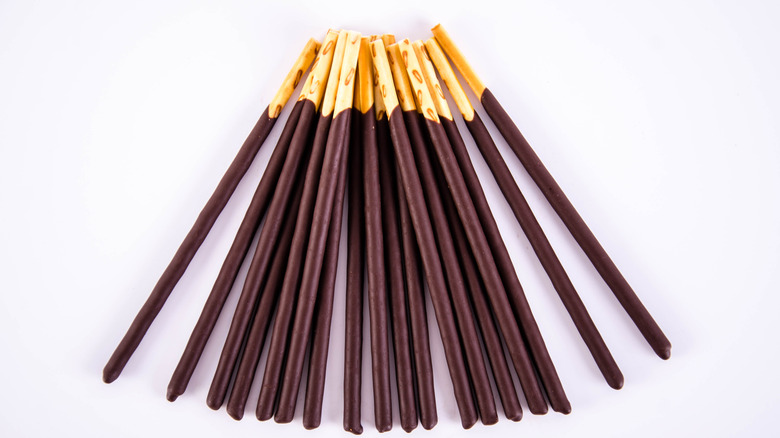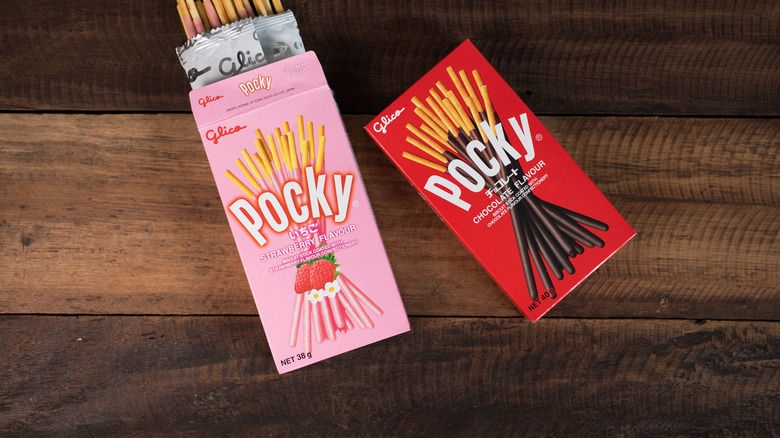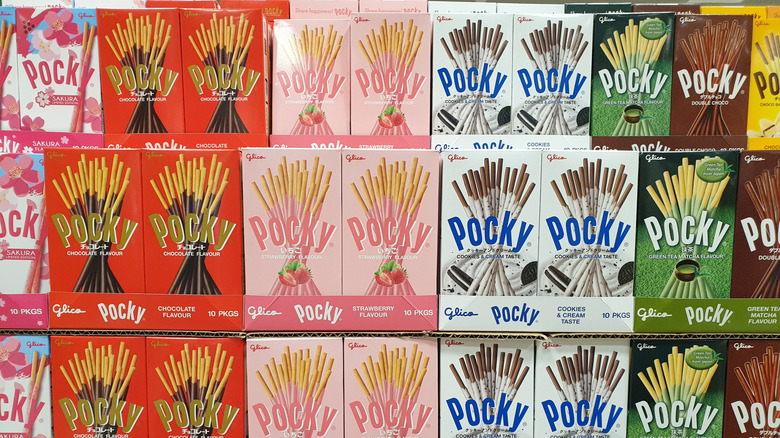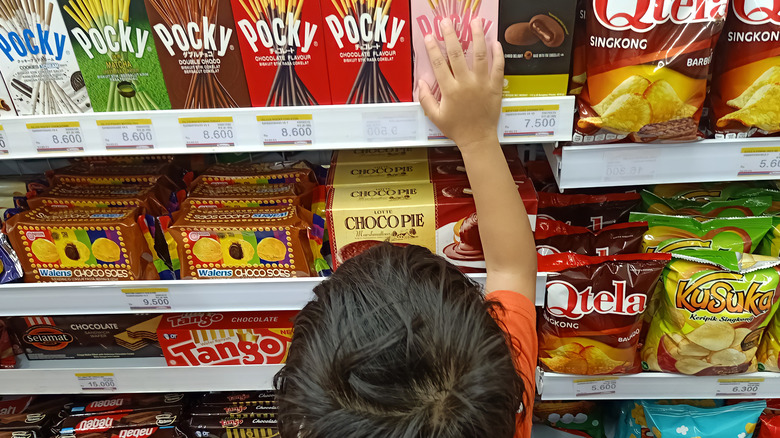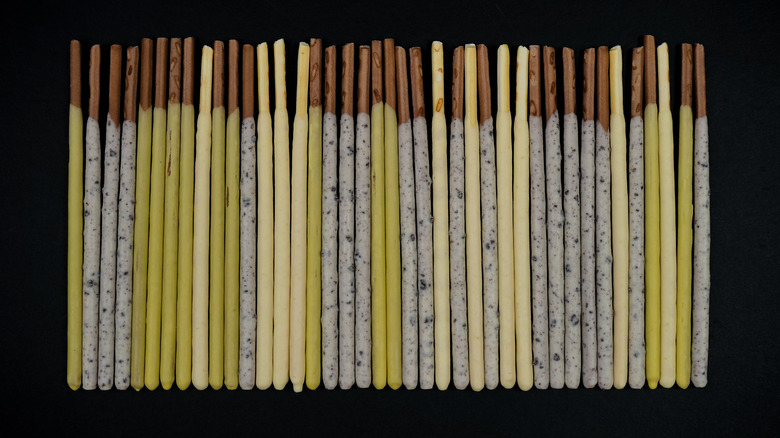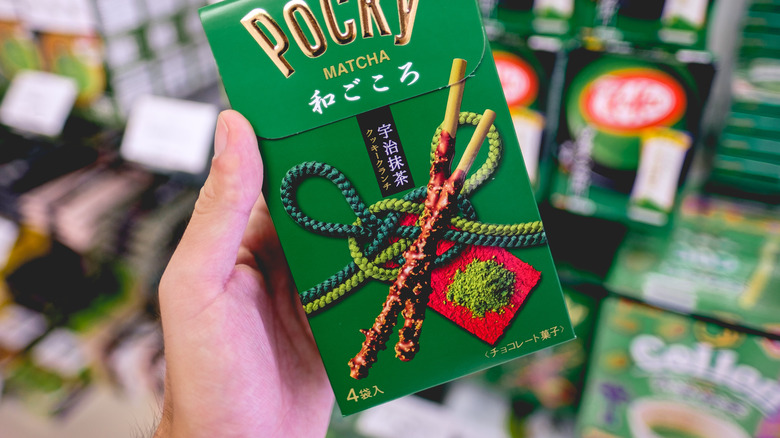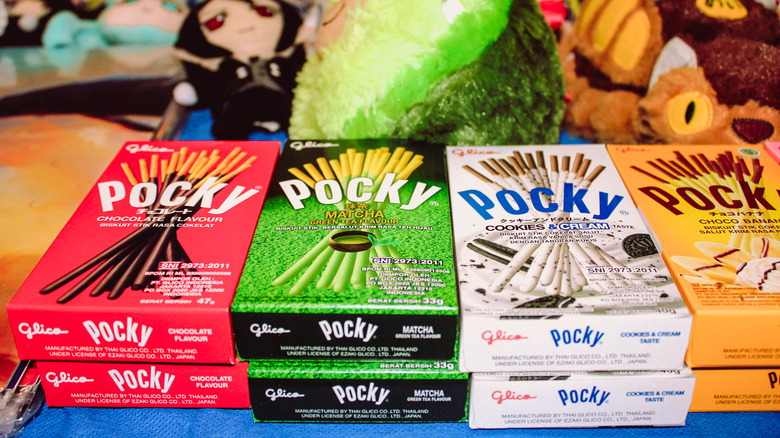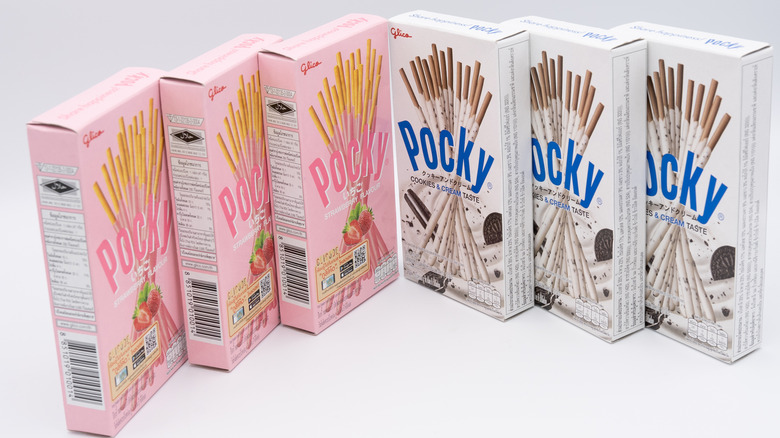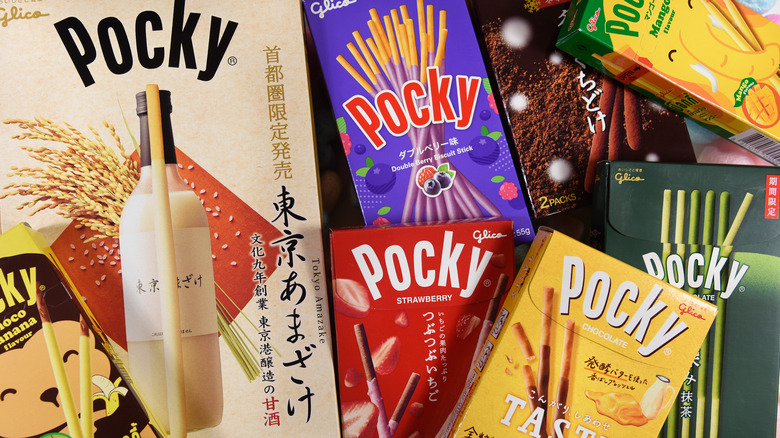The Untold Truth Of Pocky
Ever since Japanese food manufacturer Glico introduced the original chocolate Pocky in 1966, these long, thin biscuit sticks partially enrobed in dark chocolate have become a global phenomenon.
In the 1970s, Glico introduced new Pocky flavors such as almond and strawberry in response to customer requests. Glico began expanding into the overseas market to bring the pleasures of Pocky to the rest of the world. First, the company focused on Asian markets by opening a production base in Thailand; then, it worked on setting up shop in Europe and North America.
The increase in Pocky fans worldwide has also seen a corresponding rise in the range of Pocky flavors: As Glico has established and popularized Pocky across the world, it also continued adopting additional flavors such as cookies and cream, along with kiwi mango, and purple sweet potato, among other flavors (via Tasting Table). Due to its popularity and its crunchy, creamy sweetness, Pocky holds a special place in the hearts of consumers as well as their pantries.
Pocky was originally designed for women on the go
Pocky was created as a sweet alternative to Glico's savory snack sticks known as Pretz (via Tofugu). Glico initially planned to simply cover unsalted Pretz sticks in chocolate. This, in itself, was a revolutionary idea, since the only forms of chocolate available in Japan at the time were imported chocolate bars (via Tasting Table).
Glico planned on marketing the snack as an appealing choice for women who wanted to snack on the go. The entire product, from the light, easy-to-carry brightly colored packaging to the size of the sticks, was geared towards convenience. The relatively small size of the packaging meant it could be easily tucked into a purse or a briefcase.
However, there was one problem: While covering the whole biscuit stick in chocolate offered a lot of delicious sweetness, it also led to a messy eating experience as the heat from the fingers tended to melt the chocolate. To resolve this problem, Glico altered its method and began leaving part of each stick undipped so that it could be used as a handle, giving Pocky the distinctive look it has to this day. And, while this product was initially geared toward women, Pocky would eventually pivot to creating flavors for men as well (via Mic).
Pocky wasn't the original name of this product
Ideally, a name for a brand product should be memorable, appealing, and above all, not already claimed by another company (via The Marketing Company). Unfortunately, the makers of Pocky discovered this the hard way. When Pocky was first introduced, Glico was more focussed on marketing the product's portability rather than the taste or the texture. This much-loved treat was initially going to be named Chocotekku, derived from the Japanese word "tekuteku," which is a word that emulates the sound of someone walking in Japanese (via Tofugu).
The name seemed like a great idea until Glico discovered that the term was already taken and trademarked by a different company. Glico was forced to think of another name and this meant honing in on some other distinctive feature of the new snack to highlight. The company decided to focus on the snack's crunch and the satisfying snap the sticks made when broken in half, which resulted in these delicious sticks being named Pocky. This new name is based on the word "pokkin," which is the Japanese sound for something snapping.
November 11 is Pocky Day in Japan
Pocky has become so beloved in its native Japan that it even has its own holiday: Pocky Day is celebrated in Japan on November 11 (via GaijinPot). This date was chosen because the numbers of the date, when written in numerical form (11/11), evoke a bunch of sticks. On this day, Pocky fans enjoy this sweet treat while also celebrating everything Pocky.
But for all its celebratory fun, the day is based on a bare-knuckled business rivalry (via Metropolis Magazine). In 1983, Korean food manufacturer Lotte launched its own line of chocolate-covered sticks called Pepero. While Glico tried to contest the product, its case was not strong enough to succeed since Pocky was not yet available for sale in Korea. When two school-aged girls gave each other Pepero sticks on November 11, it started a nationwide trend.
The informal holiday has grown so popular that sales surrounding the day tend to account for about for around 50% of Lotte's yearly earnings. Not to be outdone, Glico deemed November 11 Pocky Day in Japan and created a tradition of celebrating these slender snack sticks with social media campaigns, launches of Pocky-shaped model rockets, and even publicity stunts (via Tofugu).
A Pocky photo montage set a Guinness World Record
Fans very much appreciate Pocky's appeal as a tasty, portable snack (via Home Tester Club). But Pocky's manufacturer, Glico, wasn't taking any chances, especially with a Korean competitor selling a very similar, and highly popular line of chocolate-covered pretzel sticks (via Metropolis Magazine). So, Glico's marketing team leaned into its Pocky Day celebrations, coming up with novel ways to engage as many Pocky fans as it could, either in person (through giveaways, games, and other activities) or through online social media campaigns (via Tofugu).
As part of the 2014 Pocky Day campaigns, Glico invited Pocky fans from around the world to participate in its world challenge by sharing pictures of themselves with Pocky. The goal of this challenge was to earn a place in the Guinness Book of World Records for the largest online photo montage of cookies/biscuits. An impressive number of Pocky aficionados sent in photos in response. The final montage included 16,825 photos and successfully landed Pocky an official world record and an entry into the Guinness Book of World Records.
Pocky can be used as a creative baking ingredient
While Pocky is satisfying and fun to eat on its own, its distinctive shape and varied flavors also make it a great addition to home baking projects, either as a decorative element or a base ingredient, or both (via Mic). Its most obvious use is in any design that requires sticks: Do you need some attractive decorations for cake pops? Pocky is your answer. Are you looking for edible spines for a hedgehog-shaped cake? Use Pocky sticks broken into short lengths.
And, if you're looking for an easy way to give a layer cake a dramatic and polished look but aren't feeling confident about your cake-frosting skills, framing your cake with whole Pocky sticks makes a visually striking (and tasty) statement. However, Pocky's appeal as a baking ingredient is based on more than just its visual impact.
Pocky wonderfully combines a light biscuit base with a deeply flavored coating, making these sticks a great way to contribute flavor and texture to cake recipes. A wonderful example of a creative incorporation of Pocky into dessert is this Matcha No-Bake Cheesecakes recipe from A Beautiful Mess. In this recipe, matcha flavored Pocky is not only used as a garnish but is crushed along with plain pretzels and mixed with butter to form the crusts for the cheesecakes.
It was renamed Rocky in Malaysia
Company products often go by different names in other countries. Companies rename products for sale in specific regions for several different reasons: For instance, the original name may not suit a different culture, or may already be legally claimed by another entity in that country (via CNBC). For example, the chain known as Burger King in the U.S. operates under the name Hungry Jack's in Australia because Burger King was already the registered trademark of a small eatery in Adelaide that didn't want to sell the rights to its name.
Pocky has also undergone several name changes as it has ventured into different parts of the world (via Guidable). In Europe, this treat has been branded as Mikado, which is a reference to a children's game involving long, thin sticks. In Malaysia, the treat was formerly branded as Rocky as Pocky is similar sounding to a Malaysian swear word. According to Pearl River Mart, the name was changed out of respect for Malaysia's predominantly Muslim population, since the word Pocky was thought to sound too much like pork, which is forbidden in the Muslim faith (via The National News).
The Pocky factory in Saitama is open for tours
If you're a Pocky superfan who just has to know everything about the history and production of your favorite snack, you're in luck: Glico's factory in Saitama's Kitamoto city in Japan is open to the public for tours (via GaijinPot). And, while visitors are met with staff, much of the tour involves a full-blown multimedia experience.
To start, a CGI robot will give you a virtual presentation on the history of Pocky and its creator, Richi Ezaki, followed by a visit to the factory floor where you will be immersed in the sights, sounds, and smells of Pocky-making in progress. And that's not all: After your tour, you can test your new Pocky knowledge against that of your fellow visitors in the factory's Quiz Room, which comes fully equipped with the kind of giant buzzers and giant screens you'd expect on a game show.
Tours are free but must be booked in advance (via Glico). Tours are in Japanese only, so if you're not familiar with the language, you might want to take along a translator or a bilingual friend.
It is offered with ice water in Asian bars
Pocky has become so enmeshed in Asian culture that in addition to being a treat sought out by hungry individuals, it has also become a staple in café and bar culture (via Bokksu). Restaurant and bar owners and staff have taken notice of Pocky's popularity and have started incorporating it into their menus.
Upon hearing that Pocky sticks were being utilized as attractive and flavorful drink stirrers in cafés and other establishments, Glico capitalized on this trend and launched a marketing campaign entitled "Pocky on the Rocks" that linked Pocky to drinking and bar culture (via Glico).
This campaign successfully framed Pocky as a delectable snack for adults and children alike. Pocky has been incorporated into cocktail recipes. It has also been served alongside alcoholic drinks as a snack, perhaps a little similar to the role that nachos and nuts in North American bars: Just like these popular bar snacks, Pocky doesn't have to be consumed with alcohol even in bars. In fact, it's quite common to serve Pocky with a glass of ice water or even milk.
Adult Pocky flavors can be paired with alcohol
When Glico discovered that this confection appealed to everyone, the company began creating flavors targeted toward various audiences: As Glico notes on its website, it launched Pocky Bitter specifically to appeal to men, while Little Pocky was created specifically (a line of shorter Pocky sticks) to appeal to young women.
While most Pocky varieties are available in kid-friendly flavors such as chocolate, strawberry, and cookies and cream, Glico also strived to create more sophisticated flavors for adults to pair with alcoholic beverages (via Bokksu). If you're a whiskey drinker, you might want to try Adult Amber Pocky, which features dark chocolate and a biscuit infused with malt extract. And, if you're a wine drinker with an adventurous palate, you can try Goddess Ruby Pocky, which features a delicious berry-infused dark chocolate that enrobing a crunchy, savory biscuit flavored with pepper, parmesan, and cheddar.
Regional flavors of Pocky are available in Japan
While Pocky has gained global popularity and takes its flavor inspirations from around the world, it has also focussed on its Japanese roots, offering traditional Japanese flavors such as matcha (green tea) and azuki (red bean) flavors (via JW). Glico has also released the Sakura (cherry blossom) Pocky, inspired by Japan's cherry blossom season in early spring (via Bokksu).
Like its namesake flower, Sakura Pocky is pale pink, with a white chocolate coating flavored with cherry blossoms. If you're wondering what cherry blossoms taste like, according to Tokyo Treat, they're floral (obviously) and reminiscent of almonds.
But if you want a seriously deep dive specifically into Pocky's Japanese flavors, you might enjoy hunting for Pocky's regional flavors, which honor the specialty products of several Japanese regions. Among these featured flavors are Yubari melon from Hokkaido and Shinshu Grape from Nagano. If any of these sound tempting to you, you're going to have to do some footwork (or spend a lot of time on planes and trains) as these local Pocky flavors are only sold in their own regions (via Tokyo Treat).
The Pocky game is flirty party fun
Pocky's European name, Mikado, refers to a popular child's game, and aptly so: Pocky sticks can be quite fun to play with, so much so that a popular Japanese party game has been built around Pocky (via Know Your Meme). The rules of the Pocky game simply entail two players who take opposite ends of a single Pocky stick in their mouths and nibble away, making their way towards the middle.
The player who flinches and lets go first loses, and, in some versions of the game, must take a drink (via Funny Game Ideas). If both players eat their way to the middle and end up touching lips, the round is considered a tie. The Pocky Game is highly popular among college students and has inspired several videos and works of visual art. The game is also frequently depicted in anime and manga.
A promo once offered augmented reality boyfriends with Pocky
It's not unusual for food manufacturers to offer a little something extra with their products such as coupons, game pieces, or small toys, particularly for special occasions such as Christmas and Valentine's Day (via Mailmunch). However, the ever-imaginative marketing team behind Pocky decided to push the envelope for their 2018 Valentine's Day promotion by offering something completely different: An augmented reality boyfriend with each box of Pocky sticks (via Tokyo Weekender).
During this promotion, Pocky boxes were adorned with anime-style illustrations of handsome young men, and each of these heartthrobs had a unique personality and back story representing each flavor. For instance, the sweetly nerdy guy from the Ultra Fine Pocky box read 50 books a month, while the boyfriend on the Heartful Strawberry box sported pink hair.
And, thanks to technology, admirers could do more than just gaze at the boxes and read the men's life stories on the back. All customers had to do to bring their "boyfriends" to life is download the augmented reality app aug! and scan the Pocky box with their camera. This let them see animated versions of their new boyfriends professing their affection in voices provided by well-known Japanese actors.
Anime often makes lightly disguised references to it
In Japan, Pocky has become such a pervasive part of everyday life that it regularly makes its way into popular culture, whether it's the annual Pocky Day celebration, the Pocky Game, or just its ubiquity across grocery and convenience stores (via AnswersToAll). Since Pocky is such an expected part of everyday life, it has also made its way into anime (via Itadakimasu Anime). After all, when anime characters aren't fighting battles, talking to animals, or engaged in other fantastical activities, they're typically doing normal stuff such as eating Pocky.
Sort of. The use of commercial trademarks in the arts can be legally fraught (via How To Geek). For instance, while some companies may welcome (and even pay for) the opportunity to place their products in popular TV shows, producers typically cover up well-known logos to avoid a licensing fee by the brand owner and due to the risk of a lawsuit if the brand owner feels a product was negatively depicted.
As Learn Japanese with Anime explains, Pocky rarely shows up in anime for these reasons. Instead, references to Pocky are cleverly, if lightly, disguised: Anime characters feed on yummy-looking chocolate-covered biscuit sticks in red boxes labeled Kocky, Packy, Lucky, and Pucky. Pocky, or a version of Pocky, makes an appearance in shows such as "Witch Craft Works," "Inari," and others.
